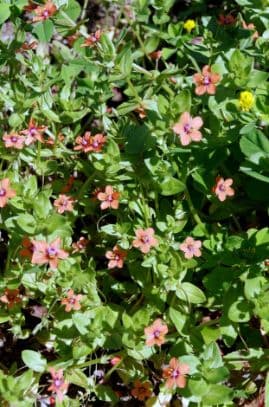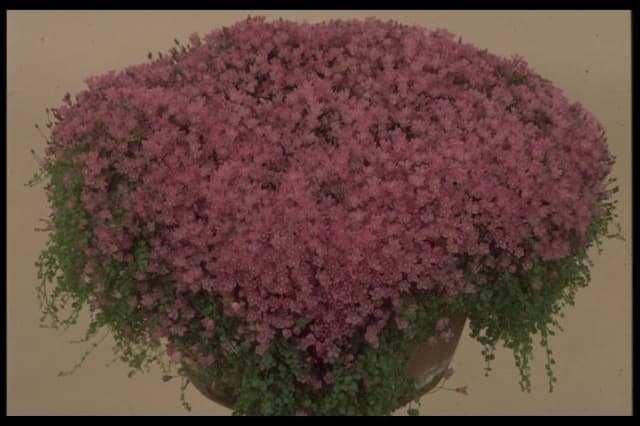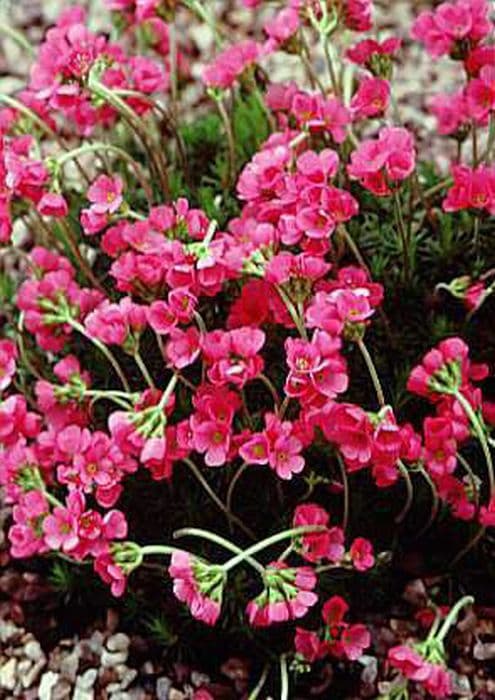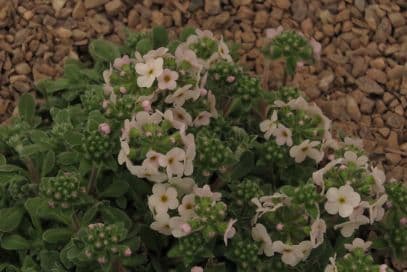Cyclamen Rhodium Cyclamen rhodium

ABOUT
The plant commonly referred to as Cyclamen is known for its distinctive and attractive appearance. This plant typically bears heart-shaped leaves that are often rich green in color with a striking silver or pale green marbling on the top surface. The underside of the leaves usually shows a different hue, often a lighter green or purplish tone. The foliage grows in a rosette shape, forming a dense cluster. The flowers of the Cyclamen are its most remarkable feature, with their unusual shape and bright colors. Each bloom consists of upright petals that elegantly curve backwards, giving them a refined and graceful look. The flowers appear on slender stems that rise above the foliage and can come in a variety of colors, including pinks, purples, whites, and reds. These petals sometimes have a silken sheen and can also display darker color at their base or along their edges, creating a delightful two-tone effect. The flowering period of Cyclamen adds an extra layer of appeal as the blossoms can persist for several weeks, providing a long-lasting splash of color. Overall, Cyclamen has a charming presence that makes it a beloved plant among gardeners and plant enthusiasts. Its ornamental leaves and striking blooms contribute to its popularity as a decorative plant, often used in indoor settings or shaded garden beds to add a touch of elegance and natural beauty.
About this plant
 Names
NamesFamily
Primulaceae
Synonyms
Rhodian Cyclamen, Cyclamen Of Rhodes
Common names
Cyclamen repandum ssp. rhodium, Cyclamen repandum var. rhodium.
 Toxicity
ToxicityTo humans
Cyclamen, specifically Cyclamen rhodium, contains toxic saponins primarily found in the tubers and roots. If ingested, it can cause symptoms such as gastrointestinal upset, which includes nausea, vomiting, and diarrhea. In severe cases, ingestion can lead to more serious effects, including heart rhythm disturbances and seizures. Contact with the skin may also cause dermatitis in sensitive individuals.
To pets
Cyclamen is also toxic to pets, such as cats and dogs. The highest concentration of toxic compounds is located in the tubers and root parts of the plant. If your pet consumes any part of the cyclamen, they may exhibit symptoms like vomiting, diarrhea, salivation, and a loss of appetite. In severe cases, ingestion can result in heart rhythm abnormalities, seizures, and even death, especially if the tubers have been eaten. Immediate veterinary attention is advised if you suspect your pet has ingested this plant.
 Characteristics
CharacteristicsLife cycle
Perennials
Foliage type
Evergreen
Color of leaves
Varies
Flower color
Varies
Height
6 inches (15 cm)
Spread
6 inches (15 cm)
Plant type
Bulb
Hardiness zones
9
Native area
Mediterranean
Benefits
 General Benefits
General Benefits- Ornamental Value: Cyclamen rhodium, commonly known as Cyclamen, adds aesthetic appeal to gardens and homes with its beautiful heart-shaped leaves and charming flowers that come in shades of pink, purple, red, and white.
- Seasonal Interest: Cyclamen blooms mainly in the fall and winter which add color and life to the garden during colder months when most other plants are dormant.
- Compact Size: Being a small plant, Cyclamen is suitable for container gardening and can be grown indoors, making it ideal for small spaces.
- Attracts Pollinators: Cyclamen flowers can attract pollinators like bees and butterflies to the garden, aiding in the pollination of surrounding plants.
- Drought Tolerance: Once established, Cyclamen is relatively drought tolerant, requiring minimal watering and being well-suited to Mediterranean-style climates.
- Low Maintenance: Cyclamen is known for being low-maintenance, requiring little care beyond occasional watering and deadheading of faded flowers.
 Medical Properties
Medical PropertiesThis plant is not used for medical purposes.
 Air-purifying Qualities
Air-purifying QualitiesThis plant is not specifically known for air purifying qualities.
 Other Uses
Other Uses- Cyclamen rhodium tubers have been used historically as a laundry starch. The crushed tubers provide a stiffening agent for fabrics.
- The flowers can serve as a natural dye source, imparting a gentle color to fabrics or artisanal crafts.
- It can be used in ornamental fish ponds as a decorative plant around the edges, however, care must be taken to prevent it from falling into the water.
- Some cultures have used the plant in traditional ceremonies and as decorations during various festivals for its ornamental value.
- Florists sometimes use dried Cyclamen rhodium flowers for creating long-lasting floral arrangements.
- The plant's ability to grow in rocky and shady areas makes it suitable for rock gardens, adding color and variety.
- Cyclamen rhodium can be featured in botanical art and photography due to its distinctive heart-shaped leaves and attractive flowers.
- In educational settings, it is sometimes used to teach botany students about plant reproduction and bulb growth.
- Gardeners may use the plant as a companion plant to indicate the health of the soil, as it prefers well-drained soil with moderate nutrients.
- Its seasonal blooms can be used as natural markers for gardeners to track the progression of the growing season.
Interesting Facts
 Feng Shui
Feng ShuiCyclamen is not used in Feng Shui practice.
 Zodiac Sign Compitability
Zodiac Sign CompitabilityCyclamen is not used in astrology practice.
 Plant Symbolism
Plant Symbolism- Enduring Love: The cyclamen's ability to thrive and bloom in cool conditions symbolizes love that endures through challenges and time.
- Sincerity: Its simple yet elegant appearance is often associated with genuine feelings and honesty in relationships.
- Goodbye: In the Victorian language of flowers, cyclamen were commonly associated with departure or a gentle farewell.
- Resilience: Cyclamen rhodium, with its capability to go dormant and survive unfavorable conditions, represents resilience and the ability to recover from adversity.
- Humility: The way cyclamen flowers appear to bow down as they grow often embodies modesty and humility.
 Water
WaterCyclamen, commonly known as Persian cyclamen, requires careful watering. It is important to water the plant when the top inch of the soil feels dry, which typically may be once per week. Avoid watering directly into the crown of the plant, as this can promote rot. Instead, water around the base of the plant or from below by placing the container in a tray of water and allowing the plant to soak up moisture. During their active growth period, they may need up to one gallon of water every 7 to 10 days, depending on environmental conditions.
 Light
LightPersian cyclamen prefers bright, indirect light. An ideal spot would be a north or east-facing window where it receives some morning light or filtered light throughout the day. Direct sunlight, especially during the hot afternoon hours, should be avoided to prevent scorching the leaves.
 Temperature
TemperaturePersian cyclamen thrives in cooler temperatures, ideally between 60°F and 70°F during the day and not dipping below 50°F at night. It is important to keep the plant away from drafts and sudden temperature changes. Extreme temperatures above 77°F or below 50°F can harm the plant.
 Pruning
PruningPruning Persian cyclamen is mainly about deadheading the spent flowers to encourage new blooms and removing yellowing or dead leaves to maintain plant health. This should be done as needed throughout the blooming season. The best time for larger pruning efforts, such as cutting back leggy growth, is after the blooming period has ended.
 Cleaning
CleaningAs needed
 Soil
SoilThe best soil mix for Cyclamen (most common name is Persian Violet) is a well-draining, humus-rich medium with a slightly acidic to neutral pH of 6.5 to 7.0. An ideal mix consists of one part perlite, one part peat, and one part potting compost.
 Repotting
RepottingPersian Violets should be repotted every one to two years, preferably in the dormant season after flowering has ceased to refresh the soil and provide space for root growth.
 Humidity & Misting
Humidity & MistingPersian Violets prefer moderate to high humidity levels, ranging from 40% to 70%, to thrive indoors or in conservatory environments.
 Suitable locations
Suitable locationsIndoor
Keep Persian Violet in bright, indirect light with cool temps.
Outdoor
Plant Persian Violet in dappled shade, shelter from heavy rain.
Hardiness zone
7-9 USDA
 Life cycle
Life cycleCyclamen rhodium, commonly known as Rhodes Cyclamen, begins its life cycle with seed germination, typically occurring in autumn when soil moisture levels increase. The seeds develop into a tuber, from which heart-shaped leaves and flowers emerge. In the flowering stage, which occurs usually in late winter and spring, the plant produces dainty flowers with reflexed petals that vary in color from white to pink with a magenta blotch at the base. After pollination, which is often assisted by insects, the flower stalks coil, bringing the developing seed pods closer to the ground. The plant goes into dormancy during the summer months when conditions are drier and warmer, retreating into the tuber underground. Cyclamen rhodium completes its life cycle as the seeds mature and are eventually dispersed in the proximity of the parent plant to begin a new generation.
 Propogation
PropogationPropogation time
Spring to Summer
Cyclamen rhodium, popularly known as silver-leaved cyclamen, is mainly propagated by seed. The best time to sow cyclamen seeds is in late summer or early fall. To propagate, the seeds should be soaked in water for 12 to 24 hours to soften the seed coat, which enhances germination. After soaking, the seeds are sown about 1 to 2 inches apart in a tray filled with a free-draining seed starting mix. The tray should be kept in a cool, shaded place, as cyclamen prefer cooler temperatures for germination, which can take several weeks to months. Once seedlings emerge and develop a few true leaves, they can be carefully transplanted into individual pots. Patience is key with cyclamen, as it can take several years for plants grown from seed to flower.









